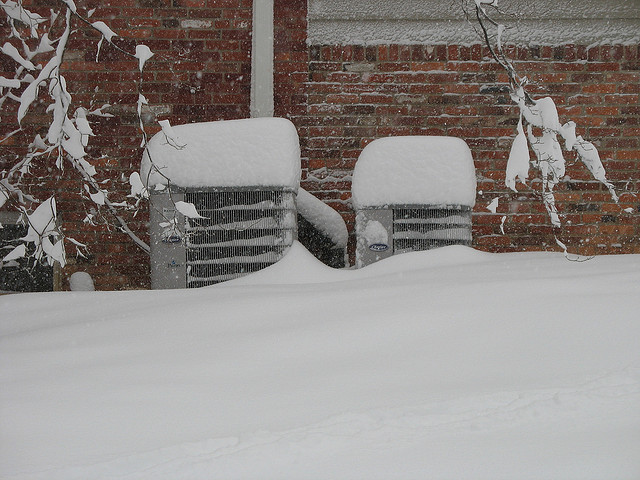My AC Pipe Is Frozen Solid - What Should I Do? Steps for Resolution
My AC Pipe Is Frozen Solid - What Should I Do? Steps for Resolution
Blog Article
Just how do you really feel in relation to Why Is Ice On My Outside Air Conditione?

Intro
Finding that your air conditioning pipeline is iced up can be worrying, especially during hot summer season when you rely on your air conditioning system the most. Understanding what to do in such a circumstance is important to prevent more damages to your air conditioning system and guarantee your convenience indoors.
Recognizing the Causes
A number of factors can contribute to the cold of an a/c pipeline. Comprehending these reasons can help you address the concern effectively.
Absence of Airflow
One common reason for a frozen AC pipeline is inadequate airflow. When the airflow over the evaporator coil is limited, it can create the coil to go down below freezing temperature, resulting in ice formation on the pipe.
Reduced Refrigerant Levels
Not enough refrigerant degrees in your air conditioner system can additionally lead to an icy pipeline. Reduced cooling agent levels can trigger the pressure in the system to drop, leading to the cold of wetness on the evaporator coil.
Winter Conditions
In colder environments, freezing temperatures outside can contribute to the freezing of AC pipes. If your a/c unit is not appropriately shielded or if there are leakages in the ductwork, cool air can penetrate the system, creating the pipeline to ice up.
Dirty Air Filters
Unclean or clogged up air filters can restrict air movement in your a/c system, resulting in different issues, including an icy pipe. It's essential to change or clean your air filters regularly to ensure proper airflow and prevent ice buildup.
Signs of a Frozen Air Conditioning Pipe
Acknowledging the indicators of a frozen air conditioning pipeline is important for punctual action.
Lowered Airflow
If you observe a considerable decline in air movement from your vents, it might show an icy pipeline.
Ice Buildup on the Pipe
Visible ice build-up on the cooling agent line or the evaporator coil is a clear indicator of a frozen a/c pipeline.
Strange Sounds from the Unit
Unusual sounds, such as hissing or gurgling, originating from your air conditioning unit can signify that there's ice existing on the pipeline.
Immediate Actions to Take
When faced with an icy air conditioning pipeline, it's essential to act promptly to prevent further damages to your air conditioning system.
Turning off the air conditioner
The first step is to shut off your a/c unit to stop the system from running and exacerbating the problem.
Checking for Blockages
Evaluate the location around the indoor device for any kind of obstructions that might be blocking airflow, such as furniture or curtains.
Defrosting the Pipe
You can use mild techniques like placing towels soaked in cozy water around the icy pipe to aid thaw it slowly.
Preventive Measures
Taking safety nets can aid stay clear of future incidents of a frozen AC pipeline.
Regular Maintenance Checks
Arrange regular upkeep get in touch with a professional HVAC specialist to guarantee that your a/c system is running efficiently.
Transforming Air Filters
Regularly change or clean your air filters to avoid air flow constraints and maintain optimal performance.
Protecting Exposed Pipes
If your air conditioner pipes are exposed to cool temperature levels, think about protecting them to stop freezing throughout winter season.
Looking For Professional Help
If DIY methods fail to resolve the problem or if you're unclear about just how to continue, it's best to look for assistance from a qualified HVAC technician.
When DIY Methods Fail
If your efforts to thaw the pipe or address various other problems are not successful, it's time to call an expert.
Significance of Hiring a Professional HVAC Technician
A licensed HVAC technician has the expertise and devices essential to detect and repair concerns with your air conditioning system securely and successfully.
Verdict
Taking care of an icy a/c pipeline can be a discouraging experience, yet knowing just how to respond can help lessen damage and restore comfort to your home. By recognizing the reasons, recognizing the indications, and taking punctual action, you can successfully address the problem and avoid future events.
What to Do If Your AC Line Is Frozen
Make Sure All Supply and Return Air Vents Are Open
If you notice problems with airflow, the first thing you should do is check your supply and return vents. Supply vents distribute clean, conditioned air throughout your home. As this air becomes stale, it’s pulled into the return vent, where it’s reconditioned before being sent back out through the supply vent.
When these vents are closed, air won’t flow in the home. Before examining your AC, check the vents in every room and ensure they’re all open.
Check for a Dirty Air Filter
Another possible cause of limited airflow is a dirty air filter. Your air conditioner’s filters catch elements you don’t want to breathe in, such as dirt and dust. Over time, filters can become clogged, ultimately blocking air from flowing in and out. The lack of airflow can then cause the entire coil to freeze and will completely restrict any air from moving through it. The AC may need to be powered off for one to two days to allow the coil to thaw after replacing the filter to allow proper functioning of the unit. This debris can also accumulate on your AC’s evaporator coil, requiring a more serious repair. In general, air filters should be cleaned regularly (about every two weeks).
Assess Your Outdoor Unit
In addition to checking your AC, assessing the outdoor unit is a good idea. Also known as the condensing unit, it works with your interior unit to release heat outside. An issue with the outdoor unit can result in rising internal temperatures.
Overgrown Shrubs or Clogged Leaves
From leaves and twigs to shrubs and debris, there’s no shortage of outdoor elements that can accumulate around your condensing unit. When these elements get lodged inside the unit, they can block airflow. Fortunately, removing the blockage can solve the problem.
Sounds of a Broken Fan
Shrubs and leaves aren’t the only things that can impede your outdoor unit’s airflow. If the fan is broken, the unit won’t be able to properly get rid of heat — which means the internal temperature won’t go down. First, make sure the fan is spinning. If it is, check for the following sounds of a broken fan:
Buzzing Rattling Screeching Hissing Clicking Preventative Measures
Nobody wants to deal with a frozen AC line. In addition to causing problems with your air conditioner, they require professional repairs. On the bright side, there are preventative measures you can take to help ensure this issue doesn’t arise in the first place.
https://www.coopergreenteam.com/blog/what-to-do-if-ac-line-frozen

I ran across that blog post about Why Is Ice On My Outside Air Conditione when surfing the search engines. Appreciated our entry? Please share it. Let other people locate it. Many thanks for taking the time to read it.
Book Your Service Report this page